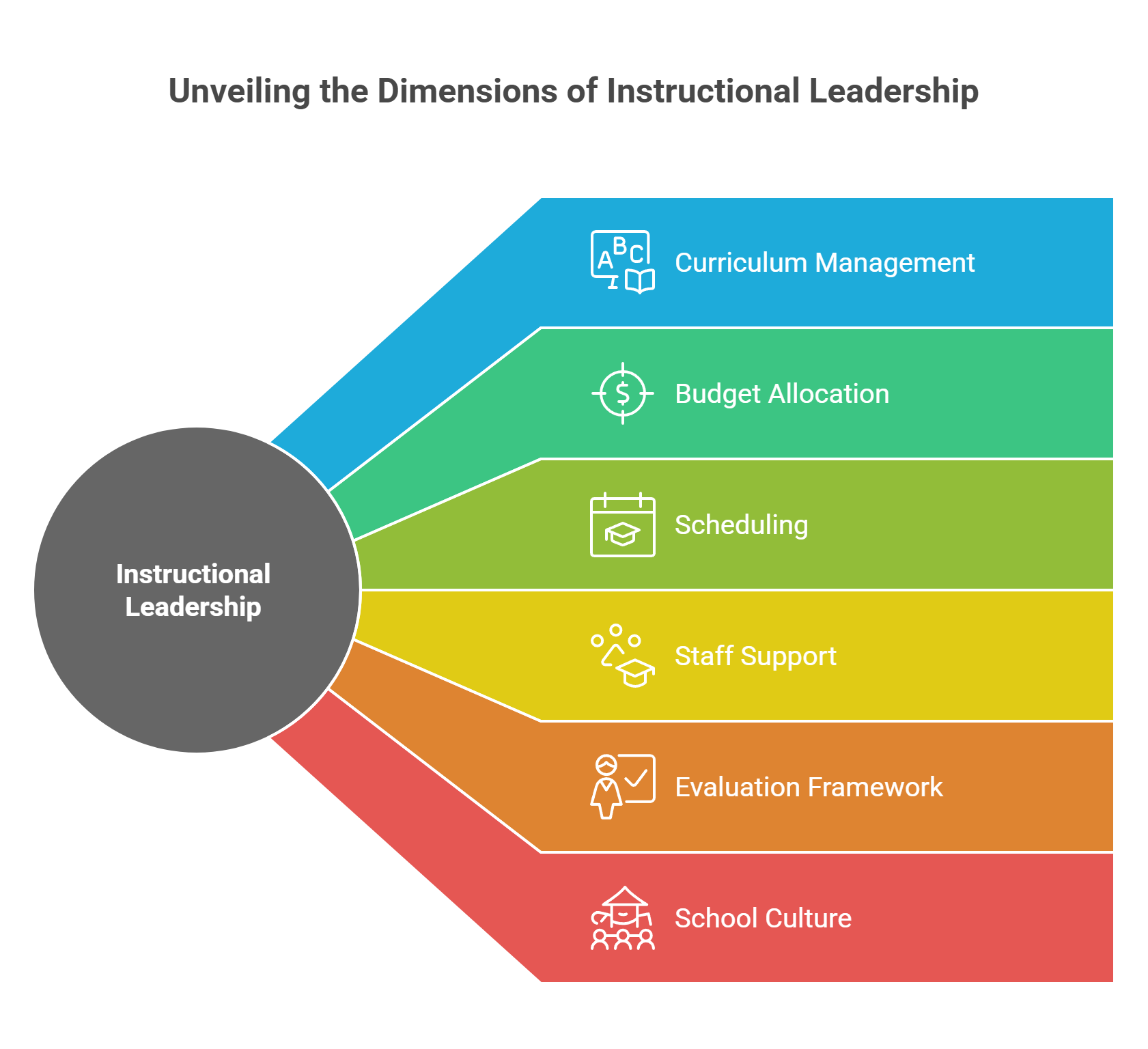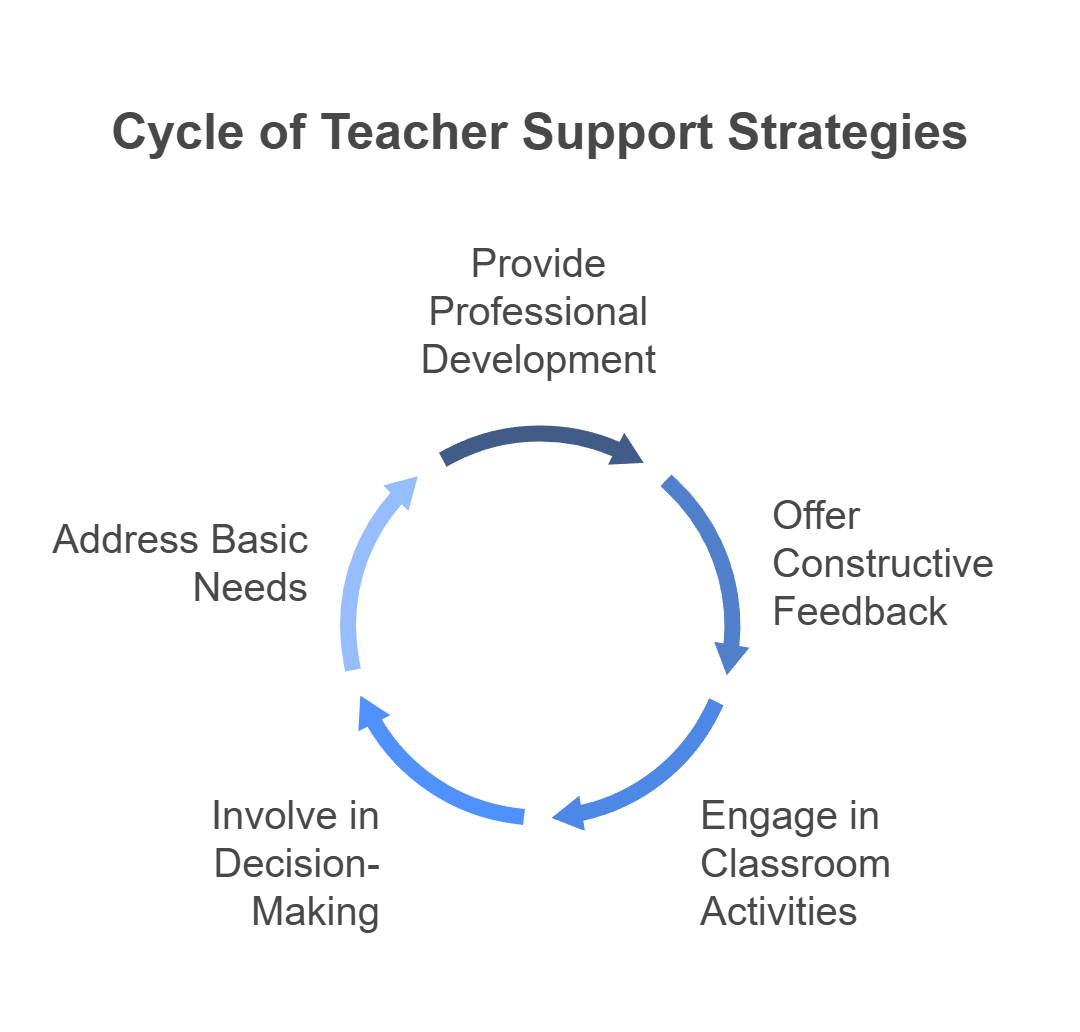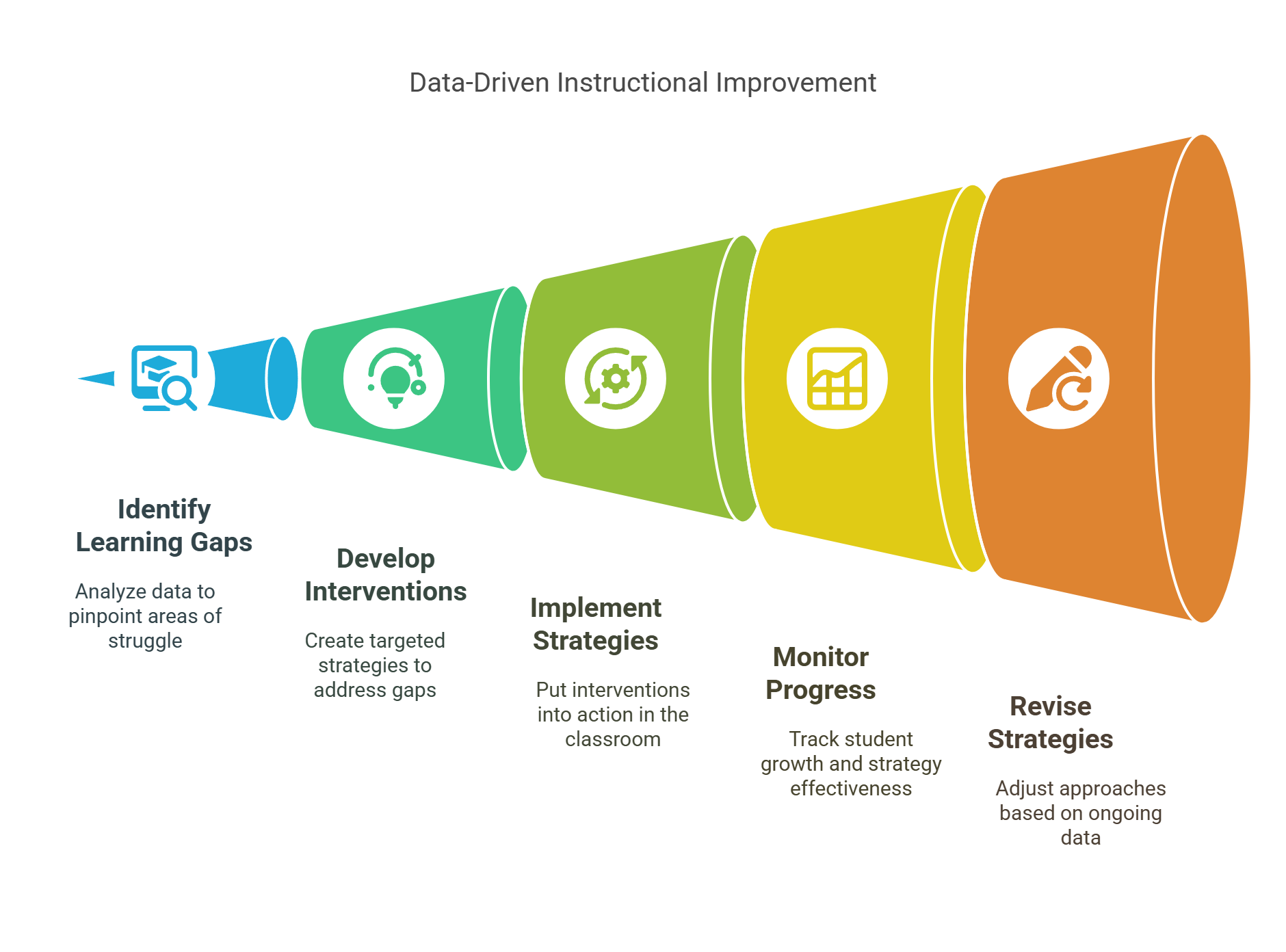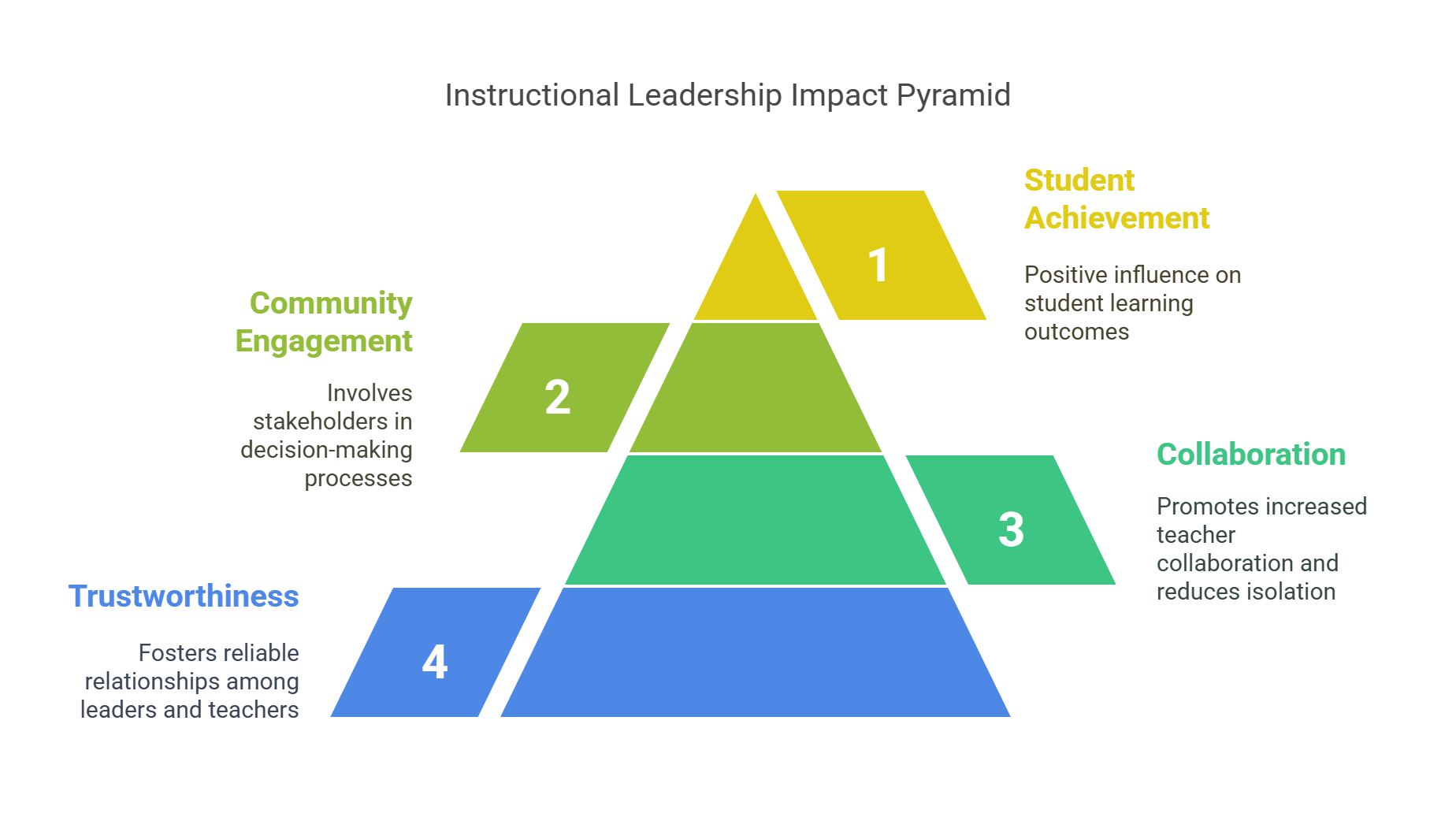
Instructional leadership involves improving teaching quality and student outcomes. In this article, we’ll discuss the roles of instructional leaders, skills they need, ways to support teachers, and strategies to enhance student learning and school culture.
Key Takeaways
- Instructional leadership enhances teaching and learning.
- It focuses on curriculum management, supporting staff, and fostering a collaborative environment aimed at improving student achievement.
- Key skills for effective instructional leadership include effective communication, curriculum development, and mentorship. These skills are essential for supporting teachers and promoting continuous improvement.
- Building a strong school culture and utilizing data-driven strategies helps to build a positive learning environment. It also helps in addressing areas for instructional development which leads to improved student outcomes.
Understanding the Role of Instructional Leaders

Instructional leadership is all about the practical actions that help teachers teach better and students learn more. Think of it as the bridge connecting great teaching with real results in the classroom. It is regarded as the most effective way to improve student learning outcomes in various educational contexts. Instructional leaders manage curriculums, budgets, and scheduling, aligning these tasks with the goal of student achievement.
The role of an instructional leader goes beyond administrative duties. They provide a framework for evaluating leadership practices and improving student achievement. Supporting their staff, shielding them from distractions, and addressing their needs, instructional leaders foster a collaborative learning environment. Great leaders focus on what really matters. They help their teams stay focused, cut through the noise, and make sure everyone has the resources needed to succeed.
At the heart of instructional leadership is the school principal, who plays a crucial role in managing the curriculum and promoting effective teaching practices. Setting high expectations for students and staff is fundamental to fostering a positive school culture and ensuring that everyone is working towards the same academic goals. In essence, school leadership focuses on practices that improve teaching and learning, creating a coherent school culture that supports educational excellence.

Essential Skills for Instructional Leadership
What makes a great instructional leader? It often comes down to a few necessary skills that help teachers and students thrive. . These skills directly influence the success of both teachers and students. Key skills include effective communication, curriculum development, and mentoring.
Being an instructional leader is like being a coach. You're not on the field scoring the points, but guiding every play, cheering, and stepping in when the strategy needs adjusting.
Strong instructional leadership advocates for the ongoing development of teaching and learning, ensuring that educators are well-equipped to address the diverse needs of their students.
Effective leaders use their skills to identify the root causes of school challenges and implement targeted interventions to improve instructional practices. Focusing on these areas allows them to create an environment conducive to professional growth and student achievement.
These types of leaders influence teacher and student success by fostering a culture of continuous improvement. Effective instructional leaders engage in professional development, set clear expectations, and provide the support teachers need to thrive. Teacher leaders play a crucial role in this process.
Strategies for Supporting Teachers

If teachers are the heartbeat of a school, then supporting them is the lifeline. Great instructional leaders know this and make it a top priority. One of the most impactful ways to support teachers is through professional development. Professional growth opportunities enable teachers to enhance their practices and address specific needs. Instructional leaders should offer timely, constructive feedback to help teachers reflect and improve.
Engaging in classroom activities and promoting peer coaching are also effective instructional leadership strategies for supporting teachers. Research has shown that “teachers display a greater tendency to stay at their schools when the leadership exercised there is instructional, with a clear emphasis on trust and support for classroom work".
With active involvement in the classroom, instructional leaders can strengthen relationships and foster a culture of collaborative growth. Involving teachers and other stakeholders in decision-making processes helps sustain improvements and enhances educational practices.
Sometimes, support is as simple as giving
- Teachers time to plan,
- The right tools for the job
- Chances to keep growing professionally.
Addressing these needs helps create an environment where teachers feel valued and supported, leading to better instructional support, teaching and learning outcomes.
Enhancing Student Learning and Achievement
Instructional leadership is crucial in aligning educational practices with academic goals, which can lead to better student outcomes. Research shows that, “Students learn substantially more in both reading and math in schools with more effective principals”. Effective instructional leadership has a strong positive impact on student learning outcomes, as it promotes a growth mindset among teachers and encourages collaborative learning. This collaborative approach reduces teacher isolation and enhances overall student achievement.
Promoting collective efficacy, where teachers collaborate to improve student outcomes, is a key benefit of shared leadership. As stated in research by Richard Ingersoll, when teachers have a large role in school improvement planning, their schools rank more than 20 percentile points higher in ELA than schools where teachers have a small role in the planning.
Fostering a collaborative learning culture helps everyone focus on the school’s academic goals. This includes setting clear expectations, providing support, and creating opportunities for professional growth.
Participants in the Instructional Leadership Professional Development (ILPD) program enhance their leadership skills by learning about student-centered instructional practices and strategies to eliminate barriers for students. This knowledge equips instructional leaders with the tools they need to support teachers and enhance student learning and achievement.

Building a Strong School Culture
A strong school culture doesn’t just happen. It’s built over time by leaders who genuinely care. When students and teachers feel safe and supported, learning is easy. Instructional leaders, often seen as ‘culture architects,’ intentionally shape an environment that supports everyone in the school. Encouraging a growth mindset among teachers leads to higher student achievement.
Ensuring a safe and caring environment helps maintain a significant amount of high expectations for student behavior. Instructional leaders must inspire educators and students to take positive actions. When the principal takes that approach, it creates a supportive school culture where everyone feels valued and motivated to achieve their best.
A strong school culture is characterized by trust, collaboration, and a shared commitment to student success. Instructional leaders establish and uphold these values throughout the school community by setting clear expectations, providing support, and creating opportunities for professional growth. As a trusted leader, they foster an environment conducive to learning.
Utilizing Data for Instructional Improvement

Monitoring student progress and using data effectively are essential functions of instructional leaders. When teachers use real-time data, it’s like having a GPS for learning. This helps them track student achievements, see where they are struggling and how to improve
Instructional leaders use data to identify learning gaps and guide schools in their efforts to improve performance. Instead of drowning in spreadsheets, a principal who notices a trend in 4th-grade math scores can take proactive actions. Rather than guessing, the principal can meet with teachers, review the assessments, and they revamp the teaching plan.
Engaging in a continuous improvement process helps you to facilitate school improvement and ensure that practices are aligned with academic goals.
According to Carin Fractor, principal of SUSD’s Bridgeport Elementary School, “When teachers see how students are learning, design interventions based on the data and see the growth, that’s what hooks them. That’s when the excitement comes".
Using a data driven approach often involves setting SMART goals based on data insights and regularly monitoring progress to determine the effectiveness of instructional strategies.
The inquiry cycle helps instructional leaders transition from data collection to implementing effective, locally-tailored strategies. This includes regular assessment and data analysis, which helps identify areas for improvement and ensure sustainable progress. Using multiple data sources, such as formative, summative, and reflective data, provides a comprehensive understanding of student progress.
Distributed Leadership in Schools
Distributed leadership involves shared responsibility through influence networks in schools. It promotes shared decision-making among multiple individuals rather than relying on a single leader. In educational settings, it involves principals collaborating with teachers and staff to share responsibilities, reflecting the distributed nature of leadership.
According to Bryk & Schneider, “Schools that embrace distributed leadership practices involving parents and communities have reported tangible improvements in student attendance rates and elevated levels of community involvement”.
An instructional leadership team typically includes teachers, principals, department heads, and other staff, working together to set school goals. This collective approach fosters a mindset where various perspectives contribute to problem-solving. Building trust and transparency is essential for the success of distributive educational leadership within schools.
Let’s face it, no one can do it all alone. That’s why effective educational leaders delegate smartly. But beyond delegation, they ensure everyone knows their role and feels ownership over shared goals. . While distributive leadership has many advantages, it can create role confusion if responsibilities are unclear. Instructional leaders play a key role in establishing clear roles and expectations to ensure everyone can delegate responsibilities while working towards the same goals.
Professional Development Opportunities for Instructional Leaders
Instructional educational leaders should model lifelong learning by engaging in professional development opportunities, including continuing education. The Instructional Leadership Professional Development (ILPD) program offers both virtual and in-person sessions for comprehensive learning experiences. It helps school leaders learn to solve complex educational leadership problems and implement effective instructional strategies that they have learned.
Deirdre Le Fevre’s research centers on practices that aid leaders in addressing complex work leadership challenges. She also explores effective methods for professional learning. Participating in professional development opportunities helps instructional leaders acquire the necessary skills and stay updated with the latest educational research and best practices.
Leaders who keep learning set the tone for the whole school. When principals grow, teachers grow, and students benefit most of all. Prioritizing their own growth sets a positive example for teachers and fosters a culture of continuous improvement within schools.

Impact of Effective Instructional Leadership on School Communities

Instructional leadership has a positive influence on student achievement. Research by Leithwood et al. shows a positive correlation between distributed leadership and improved student learning outcomes. The indirect impact of instructional leadership on student achievement manifests through effective classroom strategies which influence teaching and learning. Trustworthiness fosters reliable relationships among instructional leaders, teachers, and students.
A well-established instructional leadership framework can enhance collective responsibility among teachers, fostering a shared commitment to student success. A benefit that makes strong instructional leadership important is coherence in educational practices. They also promote increased teacher collaboration and reduce teacher isolation.
Building partnerships with parents and community stakeholders enhances the educational experience for students. Involving the broader school community in informed decisions during decision-making processes, helps instructional leaders create a supportive environment that promotes student success and fosters a sense of belonging.
Implementing Systems for Continuous Improvement
Instructional leaders must prioritize teacher growth, fostering an atmosphere conducive to innovation. Implementing systems for continuous improvement ensures schools are always moving towards higher academic excellence.
Creating systems for continuous improvement involves setting clear goals, using data systems for decision-making, and regularly monitoring learner progress. Instructional leaders must engage stakeholders in the improvement process and provide the support teachers need to succeed, ensuring educational practices evolve to meet student needs. To achieve this, it is essential to implement systems that support improving teaching initiatives and create systems that enhance overall effectiveness.
Additionally, instructional leaders that prioritize continuous improvement can create a culture of excellence within their schools. This involves encouraging a growth mindset, collaboration, and providing opportunities for professional development. When you implement these strategies, you can ensure that their schools are always striving for academic excellence.
Summary
Effective instructional leadership is crucial for enhancing teaching and learning outcomes in schools. It often involves understanding the role of instructional leaders, developing essential skills, and implementing strategies to support teachers and enhance student achievement. With these in place, school leaders can create a positive and thriving learning environment.
Moreover, building a strong school culture, utilizing data, and embracing shared leadership further contribute to the success of instructional leadership. Applying these strategies, leaders can make a lasting impact on their school communities.
Need to improve teacher and student outcomes through instructional leadership?
Book a free consultation to get started.
Frequently Asked Questions
What is instructional leadership?
Instructional leadership involves managing curriculums, supporting teachers, and fostering a positive learning environment. Effective instructional leaders prioritize these elements to improve educational outcomes.
What are the essential skills for effective instructional leadership?
Effective instructional leadership requires strong communication, curriculum development, and mentoring skills. It is also essential for supporting teachers and enhancing student learning outcomes. Prioritizing these skills enables leaders to foster a productive educational environment.
How can instructional leaders support teachers?
Instructional leaders can effectively support teachers by offering professional development, providing constructive feedback, and facilitating peer coaching. Engaging teachers in decision-making further strengthens educational practices and sustains improvements.
What is the impact of effective instructional leadership on student achievement?
Effective instructional leadership significantly enhances student achievement by fostering a growth mindset in teachers. It also facilitates collaborative learning, and ensures that educational practices are closely aligned with academic goals.
What is distributed leadership in schools?
Distributed leadership in schools involves the collaborative sharing of responsibilities and decision-making among principals, teachers, and staff. This approach enhances overall school effectiveness by promoting a sense of collective ownership and accountability.